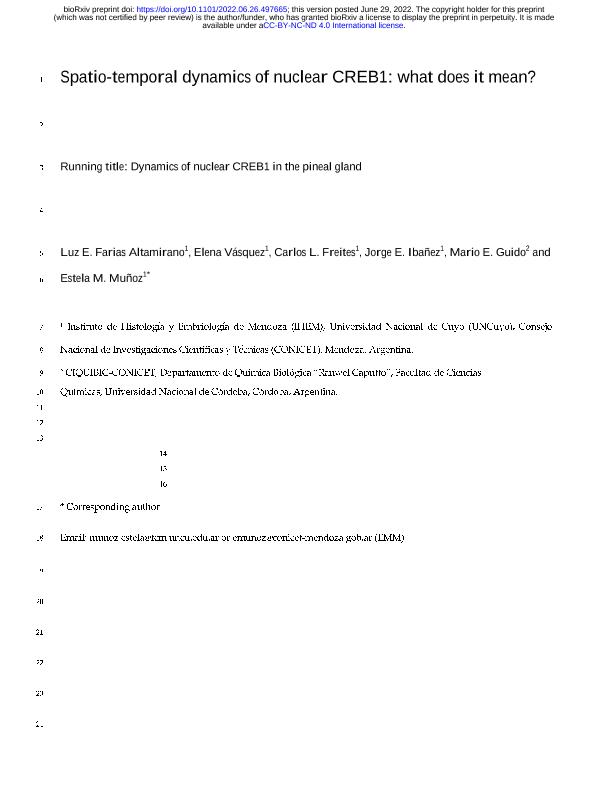Mostrar el registro sencillo del ítem
dc.contributor.author
Farías Altamirano, Luz Estefanía

dc.contributor.author
Vásquez, Elena

dc.contributor.author
Freites, Carlos Leandro

dc.contributor.author
Ibañez, Jorge Ernesto

dc.contributor.author
Guido, Mario Eduardo

dc.contributor.author
Muñoz, Estela Maris

dc.date.available
2023-07-19T11:45:03Z
dc.date.issued
2022-06
dc.identifier.citation
Farías Altamirano, Luz Estefanía; Vásquez, Elena; Freites, Carlos Leandro; Ibañez, Jorge Ernesto; Guido, Mario Eduardo; et al.; Spatio-temporal dynamics of nuclear CREB1: what does it mean?; Cold Spring Harbor Laboratory (CSH); bioRxiv; 2022; 6-2022; 1-43
dc.identifier.issn
2692-8205
dc.identifier.uri
http://hdl.handle.net/11336/204383
dc.description.abstract
In the mammalian pineal gland (PG), cyclic AMP responsive element-binding protein 1 (CREB1) participates in the nocturnal melatonin synthesis that rhythmically modulates physiology and behavior. Phosphorylation of CREB1 present in pinealocyte nuclei is one of the key regulatory steps that drives pineal transcription. The spatio-temporal dynamics of CREB1 itself within PG cell types have not yet been documented. In this study we analyzed total CREB1 via Western blot, and the dynamism of CREB1 nuclear distribution in individual rat pinealocytes using fluorescence immunohistochemistry followed by confocal laser-scanning microscopy and quantitative analysis. Total CREB1 levels remained constant in the PG throughout the light:dark cycle. The distribution pattern of nuclear CREB1 did vary, however, among different PG cells. Pinealocytes emerged as having discrete CREB1 domains within their nucleoplasm that were especially distinct. The number, size, and location of CREB1 foci fluctuated among pinealocytes, within the same PG and among Zeitgeber times. A significantly larger dispersion of CREB1-immunoreactive nuclear sites was found at night. This was not accompanied by changes in the overall transcription activity, which was mostly conserved between the light and dark phases, as shown by the expression of a particular phosphorylated form of the RNA polymerase II (RNAPII-pSer5CTD). Suppression of the nocturnal norepinephrine pulse by chronic bilateral superior cervical ganglionectomy increased CREB1 dispersion in pinealocyte nuclei, as compared to sham-derived cells. In addition, differences in CREB1 distribution were found between sham-operated and non-operated rats at early night. Together, these data suggest that in mature pinealocytes nuclear CREB1 is subjected to a dynamic spatio-temporal distribution. Further studies are necessary to elucidate the underlying mechanisms, including the role of chromatin and interchromatin elements, and to understand the impact of CREB1 reorganization in the pineal transcriptome.
dc.format
application/pdf
dc.language.iso
eng
dc.publisher
Cold Spring Harbor Laboratory (CSH)
dc.rights
info:eu-repo/semantics/openAccess
dc.rights.uri
https://creativecommons.org/licenses/by-nc-nd/2.5/ar/
dc.subject
CREB1
dc.subject
PINEAL GLAND
dc.subject
TRANSCRIPTION FACTOR
dc.subject
SPATIO-TEMPORAL DYNAMICS
dc.subject.classification
Otros Tópicos Biológicos

dc.subject.classification
Ciencias Biológicas

dc.subject.classification
CIENCIAS NATURALES Y EXACTAS

dc.title
Spatio-temporal dynamics of nuclear CREB1: what does it mean?
dc.type
info:eu-repo/semantics/article
dc.type
info:ar-repo/semantics/artículo
dc.type
info:eu-repo/semantics/publishedVersion
dc.date.updated
2023-07-18T14:21:22Z
dc.journal.volume
2022
dc.journal.pagination
1-43
dc.journal.pais
Estados Unidos

dc.description.fil
Fil: Farías Altamirano, Luz Estefanía. Consejo Nacional de Investigaciones Científicas y Técnicas. Centro Científico Tecnológico Conicet - Mendoza. Instituto de Histología y Embriología de Mendoza Dr. Mario H. Burgos. Universidad Nacional de Cuyo. Facultad de Ciencias Médicas. Instituto de Histología y Embriología de Mendoza Dr. Mario H. Burgos; Argentina
dc.description.fil
Fil: Vásquez, Elena. Consejo Nacional de Investigaciones Científicas y Técnicas. Centro Científico Tecnológico Conicet - Mendoza. Instituto de Histología y Embriología de Mendoza Dr. Mario H. Burgos. Universidad Nacional de Cuyo. Facultad de Ciencias Médicas. Instituto de Histología y Embriología de Mendoza Dr. Mario H. Burgos; Argentina
dc.description.fil
Fil: Freites, Carlos Leandro. Consejo Nacional de Investigaciones Científicas y Técnicas. Centro Científico Tecnológico Conicet - Mendoza. Instituto de Histología y Embriología de Mendoza Dr. Mario H. Burgos. Universidad Nacional de Cuyo. Facultad de Ciencias Médicas. Instituto de Histología y Embriología de Mendoza Dr. Mario H. Burgos; Argentina
dc.description.fil
Fil: Ibañez, Jorge Ernesto. Consejo Nacional de Investigaciones Científicas y Técnicas. Centro Científico Tecnológico Conicet - Mendoza. Instituto de Histología y Embriología de Mendoza Dr. Mario H. Burgos. Universidad Nacional de Cuyo. Facultad de Ciencias Médicas. Instituto de Histología y Embriología de Mendoza Dr. Mario H. Burgos; Argentina
dc.description.fil
Fil: Guido, Mario Eduardo. Consejo Nacional de Investigaciones Científicas y Técnicas. Centro Científico Tecnológico Conicet - Córdoba. Centro de Investigaciones en Química Biológica de Córdoba. Universidad Nacional de Córdoba. Facultad de Ciencias Químicas. Centro de Investigaciones en Química Biológica de Córdoba; Argentina
dc.description.fil
Fil: Muñoz, Estela Maris. Consejo Nacional de Investigaciones Científicas y Técnicas. Centro Científico Tecnológico Conicet - Mendoza. Instituto de Histología y Embriología de Mendoza Dr. Mario H. Burgos. Universidad Nacional de Cuyo. Facultad de Ciencias Médicas. Instituto de Histología y Embriología de Mendoza Dr. Mario H. Burgos; Argentina
dc.journal.title
bioRxiv
dc.relation.alternativeid
info:eu-repo/semantics/altIdentifier/url/https://www.biorxiv.org/content/10.1101/2022.06.26.497665v1
dc.relation.alternativeid
info:eu-repo/semantics/altIdentifier/doi/https://doi.org/10.1101/2022.06.26.497665
Archivos asociados
